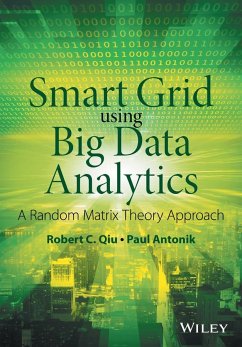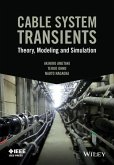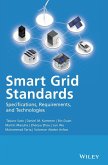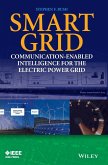- Gebundenes Buch
- Merkliste
- Auf die Merkliste
- Bewerten Bewerten
- Teilen
- Produkt teilen
- Produkterinnerung
- Produkterinnerung
This book is aimed at students in communications and signal processing who want to extend their skills in the energy area. It describes power systems and why these backgrounds are so useful to smart grid, wireless communications being very different to traditional wireline communications.
Andere Kunden interessierten sich auch für
![Cable System Transients Cable System Transients]() Akihiro AmetaniCable System Transients154,99 €
Akihiro AmetaniCable System Transients154,99 €![Power System Restoration Power System Restoration]() M. M. Adibi (Hrsg.)Power System Restoration237,99 €
M. M. Adibi (Hrsg.)Power System Restoration237,99 €![Handbook of Power Quality Handbook of Power Quality]() Angelo BagginiHandbook of Power Quality225,99 €
Angelo BagginiHandbook of Power Quality225,99 €![Flexible Power Transmission Flexible Power Transmission]() Jos ArrillagaFlexible Power Transmission165,99 €
Jos ArrillagaFlexible Power Transmission165,99 €![Smart Grid Standards Smart Grid Standards]() Takuro SatoSmart Grid Standards128,99 €
Takuro SatoSmart Grid Standards128,99 €![State Variables for Engineers State Variables for Engineers]() Paul M DerussoState Variables for Engineers186,99 €
Paul M DerussoState Variables for Engineers186,99 €![Smart Grid Smart Grid]() Stephen F. BushSmart Grid101,99 €
Stephen F. BushSmart Grid101,99 €-
-
-
This book is aimed at students in communications and signal processing who want to extend their skills in the energy area. It describes power systems and why these backgrounds are so useful to smart grid, wireless communications being very different to traditional wireline communications.
Produktdetails
- Produktdetails
- Verlag: Wiley & Sons
- 1. Auflage
- Seitenzahl: 632
- Erscheinungstermin: 17. April 2017
- Englisch
- Abmessung: 253mm x 177mm x 35mm
- Gewicht: 1067g
- ISBN-13: 9781118494059
- ISBN-10: 1118494059
- Artikelnr.: 41628832
- Herstellerkennzeichnung
- Libri GmbH
- Europaallee 1
- 36244 Bad Hersfeld
- gpsr@libri.de
- Verlag: Wiley & Sons
- 1. Auflage
- Seitenzahl: 632
- Erscheinungstermin: 17. April 2017
- Englisch
- Abmessung: 253mm x 177mm x 35mm
- Gewicht: 1067g
- ISBN-13: 9781118494059
- ISBN-10: 1118494059
- Artikelnr.: 41628832
- Herstellerkennzeichnung
- Libri GmbH
- Europaallee 1
- 36244 Bad Hersfeld
- gpsr@libri.de
Robert Caiming Qiu, Professor, Dept. of ECE, Tennessee Technological University, Cookeville, TN, USA. Professor Qiu was Founder-CEO and President of Wiscom Technologies, Inc., manufacturing and marketing WCDMA chipsets. Wiscom was acquired by Intel in 2003. Prior to Wiscom, he worked for GTE Labs, Inc. (now Verizon), Waltham, MA, and Bell Labs, Lucent, Whippany, NJ. He holds 5 U.S. patents (another two pending) in WCDMA. Professor Qiu has contributed to 3GPP and IEEE standards bodies, and delivered invited seminars to institutions including Princeton University and the U.S. Army Research Lab. Dr. Qiu was made an IEEE Fellow in 2014. Dr. Paul Antonik, Chief Scientist, Information Directorate, Air Force Research Laboratory, Rome, N.Y., USA. Dr. Antonik serves as the directorate's principal scientific and technical adviser and primary authority for the technical content of the science and technology portfolio, providing principal technical oversight of a broad spectrum of information technologies.
Preface xv
Acknowledgments xix
Some Notation xxi
1 Introduction 1
1.1 Big Data: Basic Concepts 1
1.2 Data Mining with Big Data 9
1.3 A Mathematical Introduction to Big Data 13
1.4 A Mathematical Theory of Big Data 28
1.5 Smart Grid 34
1.6 Big Data and Smart Grid 36
1.7 Reading Guide 37
Bibliographical Remarks 39
Part I Fundamentals of Big Data 41
2 The Mathematical Foundations of Big Data Systems 43
2.1 Big Data Analytics 44
2.2 Big Data: Sense, Collect, Store, and Analyze 45
2.3 Intelligent Algorithms 48
2.4 Signal Processing for Smart Grid 48
2.5 Monitoring and Optimization for Power Grids 48
2.6 Distributed Sensing and Measurement for Power Grids 49
2.7 Real-time Analysis of Streaming Data 50
2.8 Salient Features of Big Data 51
2.9 Big Data for Quantum Systems 54
2.10 Big Data for Financial Systems 55
2.11 Big Data for Atmospheric Systems 73
2.12 Big Data for Sensing Networks 74
2.13 Big Data forWireless Networks 75
2.14 Big Data for Transportation 78
Bibliographical Remarks 78
3 Large Random Matrices: An Introduction 79
3.1 Modeling of Large Dimensional Data as Random Matrices 79
3.2 A Brief of Random MatrixTheory 81
3.3 Change Point of Views: From Vectors to Measures 85
3.4 The Stieltjes Transform of Measures 86
3.5 A Fundamental Result: The Marchenko-Pastur Equation 88
3.6 Linear Eigenvalue Statistics and Limit Laws 89
3.7 Central LimitTheorem for Linear Eigenvalue Statistics 99
3.8 Central LimitTheorem for Random Matrix S¿1T 101
3.9 Independence for Random Matrices 103
3.10 Matrix-Valued Gaussian Distribution 110
3.11 Matrix-ValuedWishart Distribution 112
3.12 Moment Method 112
3.13 Stieltjes Transform Method 113
3.14 Concentration of the Spectral Measure for Large Random Matrices 114
3.15 Future Directions 117
Bibliographical Remarks 117
4 Linear Spectral Statistics of the Sample Covariance Matrix 121
4.1 Linear Spectral Statistics 121
4.2 Generalized Marchenko-Pastur Distributions 122
4.3 Estimation of Spectral Density Functions 127
4.4 Limiting Spectral Distribution of Time Series 146
Bibliographical Remarks 154
5 Large Hermitian Random Matrices and Free Random Variables 155
5.1 Large Economic/Financial Systems 156
5.2 Matrix-Valued Probability 157
5.3 Wishart-Levy Free Stable Random Matrices 166
5.4 Basic Concepts for Free Random Variables 168
5.5 The Analytical Spectrum of theWishart-Levy Random Matrix 172
5.6 Basic Properties of the Stieltjes Transform 176
5.7 Basic Theorems for the Stieltjes Transform 179
5.8 Free Probability for Hermitian Random Matrices 185
5.9 Random Vandermonde Matrix 196
5.10 Non-Asymptotic Analysis of State Estimation 200
Bibliographical Remarks 201
6 Large Non-Hermitian Random Matrices and Quatartenionic Free Probability
Theory 203
6.1 Quatartenionic Free ProbabilityTheory 204
6.2 R-diagonalMatrices 209
6.3 The Sum of Non-Hermitian Random Matrices 216
6.4 The Product of Non-Hermitian Random Matrices 220
6.5 Singular Value Equivalent Models 226
6.6 The Power of the Non-Hermitian Random Matrix 234
6.7 Power Series of Large Non-Hermitian Random Matrices 239
6.8 Products of Random Ginibre Matrices 246
6.9 Products of Rectangular Gaussian Random Matrices 249
6.10 Product of ComplexWishart Matrices 252
6.11 Spectral Relations between Products and Powers 254
6.12 Products of Finite-Size I.I.D. Gaussian Random Matrices 258
6.13 Lyapunov Exponents for Products of Complex Gaussian Random Matrices
260
6.14 Euclidean Random Matrices 264
6.15 Random Matrices with Independent Entries and the Circular Law 273
6.16 The Circular Law and Outliers 275
6.17 Random SVD, Single Ring Law, and Outliers 285
6.18 The Elliptic Law and Outliers 295
Bibliographical Remarks 305
7 The Mathematical Foundations of Data Collection 307
7.1 Architectures and Applications for Big Data 307
7.2 Covariance Matrix Estimation 308
7.3 Spectral Estimators for Large Random Matrices 312
7.4 Asymptotic Framework for Matrix Reconstruction 319
7.5 Optimum Shrinkage 329
7.6 A Shrinkage Approach to Large-Scale Covariance Matrix Estimation 331
7.7 Eigenvectors of Large Sample Covariance Matrix Ensembles 338
7.8 A General Class of Random Matrices 351
Bibliographical Remarks 359
8 Matrix Hypothesis Testing using Large RandomMatrices 361
8.1 Motivating Examples 362
8.2 Hypothesis Test of Two Alternative Random Matrices 363
8.3 Eigenvalue Bounds for Expectation and Variance 364
8.4 Concentration of Empirical Distribution Functions 369
8.5 Random Quadratic Forms 381
8.6 Log-Determinant of Random Matrices 382
8.7 General MANOVA Matrices 383
8.8 Finite Rank Perturbations of Large Random Matrices 386
8.9 Hypothesis Tests for High-Dimensional Datasets 391
8.9.1 Motivation for Likelihood Ratio Test (LRT) and Covariance Matrix
Tests 392
8.10 Roy's Largest Root Test 428
8.11 Optimal Tests of Hypotheses for Large Random Matrices 431
8.12 Matrix Elliptically Contoured Distributions 444
8.13 Hypothesis Testing for Matrix Elliptically Contoured Distributions 446
Bibliographical Remarks 452
Part II Smart Grid 455
9 Applications and Requirements of Smart Grid 457
9.1 History 457
9.2 Concepts and Vision 458
9.3 Today's Electric Grid 459
9.4 Future Smart Electrical Energy System 464
10 Technical Challenges for Smart Grid 471
Bibliographical Remarks 483
11 Big Data for Smart Grid 485
11.1 Power in Numbers: Big Data and Grid Infrastructure 485
11.2 Energy's Internet:The Convergence of Big Data and the Cloud 486
11.3 Edge Analytics: Consumers, Electric Vehicles, and Distributed
Generation 486
11.4 CrosscuttingThemes: Big Data 486
11.5 Cloud Computing for Smart Grid 488
11.6 Data Storage, Data Access and Data Analysis 488
11.7 The State-of-the-Art Processing Techniques of Big Data 488
11.8 Big Data Meets the Smart Electrical Grid 488
11.9 4Vs of Big Data: Volume, Variety, Value and Velocity 489
11.10 Cloud Computing for Big Data 490
11.11 Big Data for Smart Grid 490
11.12 Information Platforms for Smart Grid 491
Bibliographical Remarks 491
12 Grid Monitoring and State Estimation 493
12.1 Phase Measurement Unit 493
12.2 Optimal PMU Placement 495
12.3 State Estimation 495
12.4 Basics of State Estimation 495
12.5 Evolution of State Estimation 496
12.6 Static State Estimation 497
12.7 Forecasting-Aided State Estimation 500
12.8 Phasor Measurement Units 501
12.9 Distributed System State Estimation 502
12.10 Event-Triggered Approaches to State Estimation 502
12.11 Bad Data Detection 502
12.12 Improved Bad Data Detection 504
12.13 Cyber-Attacks 504
12.14 Line Outage Detection 504
Bibliographical Remarks 504
13 False Data Injection Attacks against State Estimation 505
13.1 State Estimation 505
13.2 False Data Injection Attacks 507
13.3 MMSE State Estimation and Generalized Likelihood Ratio Test 508
13.4 Sparse Recovery from Nonlinear Measurements 512
13.5 Real-Time Intrusion Detection 515
Bibliographical Remarks 515
14 Demand Response 517
14.1 Why Engage Demand? 517
14.2 Optimal Real-time Pricing Algorithms 520
14.3 Transportation Electrification and Vehicle-to-Grid Applications 522
14.4 Grid Storage 522
Bibliographical Remarks 523
Part III Communications and Sensing 525
15 Big Data for Communications 527
15.1 5G and Big Data 527
15.2 5GWireless Communication Networks 527
15.3 Massive Multiple Input, Multiple Output 528
15.4 Free Probability for the Capacity of the Massive MIMO Channel 537
15.5 Spectral Sensing for Cognitive Radio 539
Bibliographical Remarks 539
16 Big Data for Sensing 541
16.1 Distributed Detection and Estimation 541
16.2 Euclidean Random Matrix 547
16.3 Decentralized Computing 548
Appendix A: Some Basic Results on Free Probability 551
Appendix B: Matrix-Valued Random Variables 557
References 567
Index 601
Acknowledgments xix
Some Notation xxi
1 Introduction 1
1.1 Big Data: Basic Concepts 1
1.2 Data Mining with Big Data 9
1.3 A Mathematical Introduction to Big Data 13
1.4 A Mathematical Theory of Big Data 28
1.5 Smart Grid 34
1.6 Big Data and Smart Grid 36
1.7 Reading Guide 37
Bibliographical Remarks 39
Part I Fundamentals of Big Data 41
2 The Mathematical Foundations of Big Data Systems 43
2.1 Big Data Analytics 44
2.2 Big Data: Sense, Collect, Store, and Analyze 45
2.3 Intelligent Algorithms 48
2.4 Signal Processing for Smart Grid 48
2.5 Monitoring and Optimization for Power Grids 48
2.6 Distributed Sensing and Measurement for Power Grids 49
2.7 Real-time Analysis of Streaming Data 50
2.8 Salient Features of Big Data 51
2.9 Big Data for Quantum Systems 54
2.10 Big Data for Financial Systems 55
2.11 Big Data for Atmospheric Systems 73
2.12 Big Data for Sensing Networks 74
2.13 Big Data forWireless Networks 75
2.14 Big Data for Transportation 78
Bibliographical Remarks 78
3 Large Random Matrices: An Introduction 79
3.1 Modeling of Large Dimensional Data as Random Matrices 79
3.2 A Brief of Random MatrixTheory 81
3.3 Change Point of Views: From Vectors to Measures 85
3.4 The Stieltjes Transform of Measures 86
3.5 A Fundamental Result: The Marchenko-Pastur Equation 88
3.6 Linear Eigenvalue Statistics and Limit Laws 89
3.7 Central LimitTheorem for Linear Eigenvalue Statistics 99
3.8 Central LimitTheorem for Random Matrix S¿1T 101
3.9 Independence for Random Matrices 103
3.10 Matrix-Valued Gaussian Distribution 110
3.11 Matrix-ValuedWishart Distribution 112
3.12 Moment Method 112
3.13 Stieltjes Transform Method 113
3.14 Concentration of the Spectral Measure for Large Random Matrices 114
3.15 Future Directions 117
Bibliographical Remarks 117
4 Linear Spectral Statistics of the Sample Covariance Matrix 121
4.1 Linear Spectral Statistics 121
4.2 Generalized Marchenko-Pastur Distributions 122
4.3 Estimation of Spectral Density Functions 127
4.4 Limiting Spectral Distribution of Time Series 146
Bibliographical Remarks 154
5 Large Hermitian Random Matrices and Free Random Variables 155
5.1 Large Economic/Financial Systems 156
5.2 Matrix-Valued Probability 157
5.3 Wishart-Levy Free Stable Random Matrices 166
5.4 Basic Concepts for Free Random Variables 168
5.5 The Analytical Spectrum of theWishart-Levy Random Matrix 172
5.6 Basic Properties of the Stieltjes Transform 176
5.7 Basic Theorems for the Stieltjes Transform 179
5.8 Free Probability for Hermitian Random Matrices 185
5.9 Random Vandermonde Matrix 196
5.10 Non-Asymptotic Analysis of State Estimation 200
Bibliographical Remarks 201
6 Large Non-Hermitian Random Matrices and Quatartenionic Free Probability
Theory 203
6.1 Quatartenionic Free ProbabilityTheory 204
6.2 R-diagonalMatrices 209
6.3 The Sum of Non-Hermitian Random Matrices 216
6.4 The Product of Non-Hermitian Random Matrices 220
6.5 Singular Value Equivalent Models 226
6.6 The Power of the Non-Hermitian Random Matrix 234
6.7 Power Series of Large Non-Hermitian Random Matrices 239
6.8 Products of Random Ginibre Matrices 246
6.9 Products of Rectangular Gaussian Random Matrices 249
6.10 Product of ComplexWishart Matrices 252
6.11 Spectral Relations between Products and Powers 254
6.12 Products of Finite-Size I.I.D. Gaussian Random Matrices 258
6.13 Lyapunov Exponents for Products of Complex Gaussian Random Matrices
260
6.14 Euclidean Random Matrices 264
6.15 Random Matrices with Independent Entries and the Circular Law 273
6.16 The Circular Law and Outliers 275
6.17 Random SVD, Single Ring Law, and Outliers 285
6.18 The Elliptic Law and Outliers 295
Bibliographical Remarks 305
7 The Mathematical Foundations of Data Collection 307
7.1 Architectures and Applications for Big Data 307
7.2 Covariance Matrix Estimation 308
7.3 Spectral Estimators for Large Random Matrices 312
7.4 Asymptotic Framework for Matrix Reconstruction 319
7.5 Optimum Shrinkage 329
7.6 A Shrinkage Approach to Large-Scale Covariance Matrix Estimation 331
7.7 Eigenvectors of Large Sample Covariance Matrix Ensembles 338
7.8 A General Class of Random Matrices 351
Bibliographical Remarks 359
8 Matrix Hypothesis Testing using Large RandomMatrices 361
8.1 Motivating Examples 362
8.2 Hypothesis Test of Two Alternative Random Matrices 363
8.3 Eigenvalue Bounds for Expectation and Variance 364
8.4 Concentration of Empirical Distribution Functions 369
8.5 Random Quadratic Forms 381
8.6 Log-Determinant of Random Matrices 382
8.7 General MANOVA Matrices 383
8.8 Finite Rank Perturbations of Large Random Matrices 386
8.9 Hypothesis Tests for High-Dimensional Datasets 391
8.9.1 Motivation for Likelihood Ratio Test (LRT) and Covariance Matrix
Tests 392
8.10 Roy's Largest Root Test 428
8.11 Optimal Tests of Hypotheses for Large Random Matrices 431
8.12 Matrix Elliptically Contoured Distributions 444
8.13 Hypothesis Testing for Matrix Elliptically Contoured Distributions 446
Bibliographical Remarks 452
Part II Smart Grid 455
9 Applications and Requirements of Smart Grid 457
9.1 History 457
9.2 Concepts and Vision 458
9.3 Today's Electric Grid 459
9.4 Future Smart Electrical Energy System 464
10 Technical Challenges for Smart Grid 471
Bibliographical Remarks 483
11 Big Data for Smart Grid 485
11.1 Power in Numbers: Big Data and Grid Infrastructure 485
11.2 Energy's Internet:The Convergence of Big Data and the Cloud 486
11.3 Edge Analytics: Consumers, Electric Vehicles, and Distributed
Generation 486
11.4 CrosscuttingThemes: Big Data 486
11.5 Cloud Computing for Smart Grid 488
11.6 Data Storage, Data Access and Data Analysis 488
11.7 The State-of-the-Art Processing Techniques of Big Data 488
11.8 Big Data Meets the Smart Electrical Grid 488
11.9 4Vs of Big Data: Volume, Variety, Value and Velocity 489
11.10 Cloud Computing for Big Data 490
11.11 Big Data for Smart Grid 490
11.12 Information Platforms for Smart Grid 491
Bibliographical Remarks 491
12 Grid Monitoring and State Estimation 493
12.1 Phase Measurement Unit 493
12.2 Optimal PMU Placement 495
12.3 State Estimation 495
12.4 Basics of State Estimation 495
12.5 Evolution of State Estimation 496
12.6 Static State Estimation 497
12.7 Forecasting-Aided State Estimation 500
12.8 Phasor Measurement Units 501
12.9 Distributed System State Estimation 502
12.10 Event-Triggered Approaches to State Estimation 502
12.11 Bad Data Detection 502
12.12 Improved Bad Data Detection 504
12.13 Cyber-Attacks 504
12.14 Line Outage Detection 504
Bibliographical Remarks 504
13 False Data Injection Attacks against State Estimation 505
13.1 State Estimation 505
13.2 False Data Injection Attacks 507
13.3 MMSE State Estimation and Generalized Likelihood Ratio Test 508
13.4 Sparse Recovery from Nonlinear Measurements 512
13.5 Real-Time Intrusion Detection 515
Bibliographical Remarks 515
14 Demand Response 517
14.1 Why Engage Demand? 517
14.2 Optimal Real-time Pricing Algorithms 520
14.3 Transportation Electrification and Vehicle-to-Grid Applications 522
14.4 Grid Storage 522
Bibliographical Remarks 523
Part III Communications and Sensing 525
15 Big Data for Communications 527
15.1 5G and Big Data 527
15.2 5GWireless Communication Networks 527
15.3 Massive Multiple Input, Multiple Output 528
15.4 Free Probability for the Capacity of the Massive MIMO Channel 537
15.5 Spectral Sensing for Cognitive Radio 539
Bibliographical Remarks 539
16 Big Data for Sensing 541
16.1 Distributed Detection and Estimation 541
16.2 Euclidean Random Matrix 547
16.3 Decentralized Computing 548
Appendix A: Some Basic Results on Free Probability 551
Appendix B: Matrix-Valued Random Variables 557
References 567
Index 601
Preface xv
Acknowledgments xix
Some Notation xxi
1 Introduction 1
1.1 Big Data: Basic Concepts 1
1.2 Data Mining with Big Data 9
1.3 A Mathematical Introduction to Big Data 13
1.4 A Mathematical Theory of Big Data 28
1.5 Smart Grid 34
1.6 Big Data and Smart Grid 36
1.7 Reading Guide 37
Bibliographical Remarks 39
Part I Fundamentals of Big Data 41
2 The Mathematical Foundations of Big Data Systems 43
2.1 Big Data Analytics 44
2.2 Big Data: Sense, Collect, Store, and Analyze 45
2.3 Intelligent Algorithms 48
2.4 Signal Processing for Smart Grid 48
2.5 Monitoring and Optimization for Power Grids 48
2.6 Distributed Sensing and Measurement for Power Grids 49
2.7 Real-time Analysis of Streaming Data 50
2.8 Salient Features of Big Data 51
2.9 Big Data for Quantum Systems 54
2.10 Big Data for Financial Systems 55
2.11 Big Data for Atmospheric Systems 73
2.12 Big Data for Sensing Networks 74
2.13 Big Data forWireless Networks 75
2.14 Big Data for Transportation 78
Bibliographical Remarks 78
3 Large Random Matrices: An Introduction 79
3.1 Modeling of Large Dimensional Data as Random Matrices 79
3.2 A Brief of Random MatrixTheory 81
3.3 Change Point of Views: From Vectors to Measures 85
3.4 The Stieltjes Transform of Measures 86
3.5 A Fundamental Result: The Marchenko-Pastur Equation 88
3.6 Linear Eigenvalue Statistics and Limit Laws 89
3.7 Central LimitTheorem for Linear Eigenvalue Statistics 99
3.8 Central LimitTheorem for Random Matrix S¿1T 101
3.9 Independence for Random Matrices 103
3.10 Matrix-Valued Gaussian Distribution 110
3.11 Matrix-ValuedWishart Distribution 112
3.12 Moment Method 112
3.13 Stieltjes Transform Method 113
3.14 Concentration of the Spectral Measure for Large Random Matrices 114
3.15 Future Directions 117
Bibliographical Remarks 117
4 Linear Spectral Statistics of the Sample Covariance Matrix 121
4.1 Linear Spectral Statistics 121
4.2 Generalized Marchenko-Pastur Distributions 122
4.3 Estimation of Spectral Density Functions 127
4.4 Limiting Spectral Distribution of Time Series 146
Bibliographical Remarks 154
5 Large Hermitian Random Matrices and Free Random Variables 155
5.1 Large Economic/Financial Systems 156
5.2 Matrix-Valued Probability 157
5.3 Wishart-Levy Free Stable Random Matrices 166
5.4 Basic Concepts for Free Random Variables 168
5.5 The Analytical Spectrum of theWishart-Levy Random Matrix 172
5.6 Basic Properties of the Stieltjes Transform 176
5.7 Basic Theorems for the Stieltjes Transform 179
5.8 Free Probability for Hermitian Random Matrices 185
5.9 Random Vandermonde Matrix 196
5.10 Non-Asymptotic Analysis of State Estimation 200
Bibliographical Remarks 201
6 Large Non-Hermitian Random Matrices and Quatartenionic Free Probability
Theory 203
6.1 Quatartenionic Free ProbabilityTheory 204
6.2 R-diagonalMatrices 209
6.3 The Sum of Non-Hermitian Random Matrices 216
6.4 The Product of Non-Hermitian Random Matrices 220
6.5 Singular Value Equivalent Models 226
6.6 The Power of the Non-Hermitian Random Matrix 234
6.7 Power Series of Large Non-Hermitian Random Matrices 239
6.8 Products of Random Ginibre Matrices 246
6.9 Products of Rectangular Gaussian Random Matrices 249
6.10 Product of ComplexWishart Matrices 252
6.11 Spectral Relations between Products and Powers 254
6.12 Products of Finite-Size I.I.D. Gaussian Random Matrices 258
6.13 Lyapunov Exponents for Products of Complex Gaussian Random Matrices
260
6.14 Euclidean Random Matrices 264
6.15 Random Matrices with Independent Entries and the Circular Law 273
6.16 The Circular Law and Outliers 275
6.17 Random SVD, Single Ring Law, and Outliers 285
6.18 The Elliptic Law and Outliers 295
Bibliographical Remarks 305
7 The Mathematical Foundations of Data Collection 307
7.1 Architectures and Applications for Big Data 307
7.2 Covariance Matrix Estimation 308
7.3 Spectral Estimators for Large Random Matrices 312
7.4 Asymptotic Framework for Matrix Reconstruction 319
7.5 Optimum Shrinkage 329
7.6 A Shrinkage Approach to Large-Scale Covariance Matrix Estimation 331
7.7 Eigenvectors of Large Sample Covariance Matrix Ensembles 338
7.8 A General Class of Random Matrices 351
Bibliographical Remarks 359
8 Matrix Hypothesis Testing using Large RandomMatrices 361
8.1 Motivating Examples 362
8.2 Hypothesis Test of Two Alternative Random Matrices 363
8.3 Eigenvalue Bounds for Expectation and Variance 364
8.4 Concentration of Empirical Distribution Functions 369
8.5 Random Quadratic Forms 381
8.6 Log-Determinant of Random Matrices 382
8.7 General MANOVA Matrices 383
8.8 Finite Rank Perturbations of Large Random Matrices 386
8.9 Hypothesis Tests for High-Dimensional Datasets 391
8.9.1 Motivation for Likelihood Ratio Test (LRT) and Covariance Matrix
Tests 392
8.10 Roy's Largest Root Test 428
8.11 Optimal Tests of Hypotheses for Large Random Matrices 431
8.12 Matrix Elliptically Contoured Distributions 444
8.13 Hypothesis Testing for Matrix Elliptically Contoured Distributions 446
Bibliographical Remarks 452
Part II Smart Grid 455
9 Applications and Requirements of Smart Grid 457
9.1 History 457
9.2 Concepts and Vision 458
9.3 Today's Electric Grid 459
9.4 Future Smart Electrical Energy System 464
10 Technical Challenges for Smart Grid 471
Bibliographical Remarks 483
11 Big Data for Smart Grid 485
11.1 Power in Numbers: Big Data and Grid Infrastructure 485
11.2 Energy's Internet:The Convergence of Big Data and the Cloud 486
11.3 Edge Analytics: Consumers, Electric Vehicles, and Distributed
Generation 486
11.4 CrosscuttingThemes: Big Data 486
11.5 Cloud Computing for Smart Grid 488
11.6 Data Storage, Data Access and Data Analysis 488
11.7 The State-of-the-Art Processing Techniques of Big Data 488
11.8 Big Data Meets the Smart Electrical Grid 488
11.9 4Vs of Big Data: Volume, Variety, Value and Velocity 489
11.10 Cloud Computing for Big Data 490
11.11 Big Data for Smart Grid 490
11.12 Information Platforms for Smart Grid 491
Bibliographical Remarks 491
12 Grid Monitoring and State Estimation 493
12.1 Phase Measurement Unit 493
12.2 Optimal PMU Placement 495
12.3 State Estimation 495
12.4 Basics of State Estimation 495
12.5 Evolution of State Estimation 496
12.6 Static State Estimation 497
12.7 Forecasting-Aided State Estimation 500
12.8 Phasor Measurement Units 501
12.9 Distributed System State Estimation 502
12.10 Event-Triggered Approaches to State Estimation 502
12.11 Bad Data Detection 502
12.12 Improved Bad Data Detection 504
12.13 Cyber-Attacks 504
12.14 Line Outage Detection 504
Bibliographical Remarks 504
13 False Data Injection Attacks against State Estimation 505
13.1 State Estimation 505
13.2 False Data Injection Attacks 507
13.3 MMSE State Estimation and Generalized Likelihood Ratio Test 508
13.4 Sparse Recovery from Nonlinear Measurements 512
13.5 Real-Time Intrusion Detection 515
Bibliographical Remarks 515
14 Demand Response 517
14.1 Why Engage Demand? 517
14.2 Optimal Real-time Pricing Algorithms 520
14.3 Transportation Electrification and Vehicle-to-Grid Applications 522
14.4 Grid Storage 522
Bibliographical Remarks 523
Part III Communications and Sensing 525
15 Big Data for Communications 527
15.1 5G and Big Data 527
15.2 5GWireless Communication Networks 527
15.3 Massive Multiple Input, Multiple Output 528
15.4 Free Probability for the Capacity of the Massive MIMO Channel 537
15.5 Spectral Sensing for Cognitive Radio 539
Bibliographical Remarks 539
16 Big Data for Sensing 541
16.1 Distributed Detection and Estimation 541
16.2 Euclidean Random Matrix 547
16.3 Decentralized Computing 548
Appendix A: Some Basic Results on Free Probability 551
Appendix B: Matrix-Valued Random Variables 557
References 567
Index 601
Acknowledgments xix
Some Notation xxi
1 Introduction 1
1.1 Big Data: Basic Concepts 1
1.2 Data Mining with Big Data 9
1.3 A Mathematical Introduction to Big Data 13
1.4 A Mathematical Theory of Big Data 28
1.5 Smart Grid 34
1.6 Big Data and Smart Grid 36
1.7 Reading Guide 37
Bibliographical Remarks 39
Part I Fundamentals of Big Data 41
2 The Mathematical Foundations of Big Data Systems 43
2.1 Big Data Analytics 44
2.2 Big Data: Sense, Collect, Store, and Analyze 45
2.3 Intelligent Algorithms 48
2.4 Signal Processing for Smart Grid 48
2.5 Monitoring and Optimization for Power Grids 48
2.6 Distributed Sensing and Measurement for Power Grids 49
2.7 Real-time Analysis of Streaming Data 50
2.8 Salient Features of Big Data 51
2.9 Big Data for Quantum Systems 54
2.10 Big Data for Financial Systems 55
2.11 Big Data for Atmospheric Systems 73
2.12 Big Data for Sensing Networks 74
2.13 Big Data forWireless Networks 75
2.14 Big Data for Transportation 78
Bibliographical Remarks 78
3 Large Random Matrices: An Introduction 79
3.1 Modeling of Large Dimensional Data as Random Matrices 79
3.2 A Brief of Random MatrixTheory 81
3.3 Change Point of Views: From Vectors to Measures 85
3.4 The Stieltjes Transform of Measures 86
3.5 A Fundamental Result: The Marchenko-Pastur Equation 88
3.6 Linear Eigenvalue Statistics and Limit Laws 89
3.7 Central LimitTheorem for Linear Eigenvalue Statistics 99
3.8 Central LimitTheorem for Random Matrix S¿1T 101
3.9 Independence for Random Matrices 103
3.10 Matrix-Valued Gaussian Distribution 110
3.11 Matrix-ValuedWishart Distribution 112
3.12 Moment Method 112
3.13 Stieltjes Transform Method 113
3.14 Concentration of the Spectral Measure for Large Random Matrices 114
3.15 Future Directions 117
Bibliographical Remarks 117
4 Linear Spectral Statistics of the Sample Covariance Matrix 121
4.1 Linear Spectral Statistics 121
4.2 Generalized Marchenko-Pastur Distributions 122
4.3 Estimation of Spectral Density Functions 127
4.4 Limiting Spectral Distribution of Time Series 146
Bibliographical Remarks 154
5 Large Hermitian Random Matrices and Free Random Variables 155
5.1 Large Economic/Financial Systems 156
5.2 Matrix-Valued Probability 157
5.3 Wishart-Levy Free Stable Random Matrices 166
5.4 Basic Concepts for Free Random Variables 168
5.5 The Analytical Spectrum of theWishart-Levy Random Matrix 172
5.6 Basic Properties of the Stieltjes Transform 176
5.7 Basic Theorems for the Stieltjes Transform 179
5.8 Free Probability for Hermitian Random Matrices 185
5.9 Random Vandermonde Matrix 196
5.10 Non-Asymptotic Analysis of State Estimation 200
Bibliographical Remarks 201
6 Large Non-Hermitian Random Matrices and Quatartenionic Free Probability
Theory 203
6.1 Quatartenionic Free ProbabilityTheory 204
6.2 R-diagonalMatrices 209
6.3 The Sum of Non-Hermitian Random Matrices 216
6.4 The Product of Non-Hermitian Random Matrices 220
6.5 Singular Value Equivalent Models 226
6.6 The Power of the Non-Hermitian Random Matrix 234
6.7 Power Series of Large Non-Hermitian Random Matrices 239
6.8 Products of Random Ginibre Matrices 246
6.9 Products of Rectangular Gaussian Random Matrices 249
6.10 Product of ComplexWishart Matrices 252
6.11 Spectral Relations between Products and Powers 254
6.12 Products of Finite-Size I.I.D. Gaussian Random Matrices 258
6.13 Lyapunov Exponents for Products of Complex Gaussian Random Matrices
260
6.14 Euclidean Random Matrices 264
6.15 Random Matrices with Independent Entries and the Circular Law 273
6.16 The Circular Law and Outliers 275
6.17 Random SVD, Single Ring Law, and Outliers 285
6.18 The Elliptic Law and Outliers 295
Bibliographical Remarks 305
7 The Mathematical Foundations of Data Collection 307
7.1 Architectures and Applications for Big Data 307
7.2 Covariance Matrix Estimation 308
7.3 Spectral Estimators for Large Random Matrices 312
7.4 Asymptotic Framework for Matrix Reconstruction 319
7.5 Optimum Shrinkage 329
7.6 A Shrinkage Approach to Large-Scale Covariance Matrix Estimation 331
7.7 Eigenvectors of Large Sample Covariance Matrix Ensembles 338
7.8 A General Class of Random Matrices 351
Bibliographical Remarks 359
8 Matrix Hypothesis Testing using Large RandomMatrices 361
8.1 Motivating Examples 362
8.2 Hypothesis Test of Two Alternative Random Matrices 363
8.3 Eigenvalue Bounds for Expectation and Variance 364
8.4 Concentration of Empirical Distribution Functions 369
8.5 Random Quadratic Forms 381
8.6 Log-Determinant of Random Matrices 382
8.7 General MANOVA Matrices 383
8.8 Finite Rank Perturbations of Large Random Matrices 386
8.9 Hypothesis Tests for High-Dimensional Datasets 391
8.9.1 Motivation for Likelihood Ratio Test (LRT) and Covariance Matrix
Tests 392
8.10 Roy's Largest Root Test 428
8.11 Optimal Tests of Hypotheses for Large Random Matrices 431
8.12 Matrix Elliptically Contoured Distributions 444
8.13 Hypothesis Testing for Matrix Elliptically Contoured Distributions 446
Bibliographical Remarks 452
Part II Smart Grid 455
9 Applications and Requirements of Smart Grid 457
9.1 History 457
9.2 Concepts and Vision 458
9.3 Today's Electric Grid 459
9.4 Future Smart Electrical Energy System 464
10 Technical Challenges for Smart Grid 471
Bibliographical Remarks 483
11 Big Data for Smart Grid 485
11.1 Power in Numbers: Big Data and Grid Infrastructure 485
11.2 Energy's Internet:The Convergence of Big Data and the Cloud 486
11.3 Edge Analytics: Consumers, Electric Vehicles, and Distributed
Generation 486
11.4 CrosscuttingThemes: Big Data 486
11.5 Cloud Computing for Smart Grid 488
11.6 Data Storage, Data Access and Data Analysis 488
11.7 The State-of-the-Art Processing Techniques of Big Data 488
11.8 Big Data Meets the Smart Electrical Grid 488
11.9 4Vs of Big Data: Volume, Variety, Value and Velocity 489
11.10 Cloud Computing for Big Data 490
11.11 Big Data for Smart Grid 490
11.12 Information Platforms for Smart Grid 491
Bibliographical Remarks 491
12 Grid Monitoring and State Estimation 493
12.1 Phase Measurement Unit 493
12.2 Optimal PMU Placement 495
12.3 State Estimation 495
12.4 Basics of State Estimation 495
12.5 Evolution of State Estimation 496
12.6 Static State Estimation 497
12.7 Forecasting-Aided State Estimation 500
12.8 Phasor Measurement Units 501
12.9 Distributed System State Estimation 502
12.10 Event-Triggered Approaches to State Estimation 502
12.11 Bad Data Detection 502
12.12 Improved Bad Data Detection 504
12.13 Cyber-Attacks 504
12.14 Line Outage Detection 504
Bibliographical Remarks 504
13 False Data Injection Attacks against State Estimation 505
13.1 State Estimation 505
13.2 False Data Injection Attacks 507
13.3 MMSE State Estimation and Generalized Likelihood Ratio Test 508
13.4 Sparse Recovery from Nonlinear Measurements 512
13.5 Real-Time Intrusion Detection 515
Bibliographical Remarks 515
14 Demand Response 517
14.1 Why Engage Demand? 517
14.2 Optimal Real-time Pricing Algorithms 520
14.3 Transportation Electrification and Vehicle-to-Grid Applications 522
14.4 Grid Storage 522
Bibliographical Remarks 523
Part III Communications and Sensing 525
15 Big Data for Communications 527
15.1 5G and Big Data 527
15.2 5GWireless Communication Networks 527
15.3 Massive Multiple Input, Multiple Output 528
15.4 Free Probability for the Capacity of the Massive MIMO Channel 537
15.5 Spectral Sensing for Cognitive Radio 539
Bibliographical Remarks 539
16 Big Data for Sensing 541
16.1 Distributed Detection and Estimation 541
16.2 Euclidean Random Matrix 547
16.3 Decentralized Computing 548
Appendix A: Some Basic Results on Free Probability 551
Appendix B: Matrix-Valued Random Variables 557
References 567
Index 601








